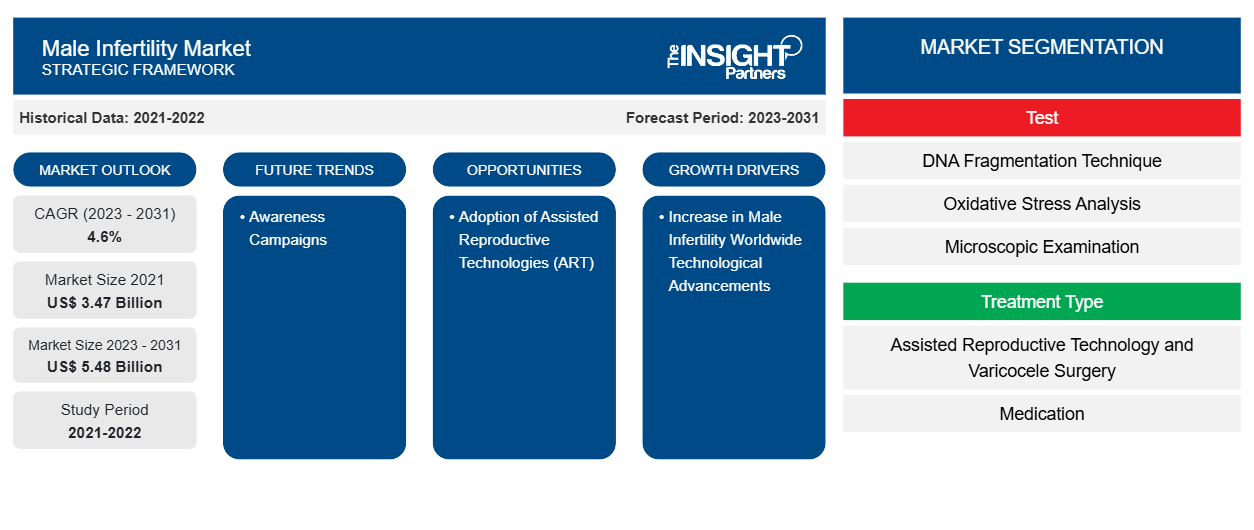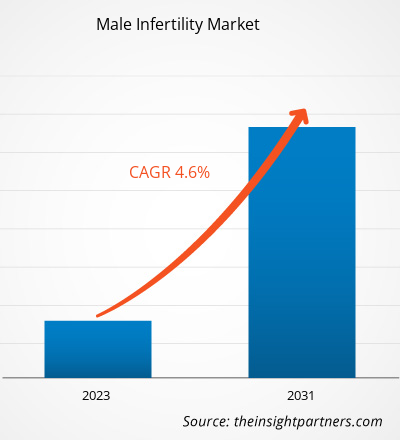The male infertility market size in 2021 stood at US$ 3.47 billion and is projected to reach US$ 5.48 billion by 2031 from US$ XX billion in 2023. The market is expected to register a CAGR of 4.6% in 2023–2031. Adoption of assisted reproductive technologies (ART) is likely to remain key male infertility market trends.
Male Infertility Market Analysis
The male infertility market is growing due to rising infertility rates, widespread adoption of assisted reproductive technology (ART), and technological advancements in ART, among other factors. Furthermore, increasing stress levels, obesity, smoking, and alcohol usage are all contributing factors to male infertility. Furthermore, greater awareness, increased R&D spending, and changing lifestyles are all driving the male infertility market.
Male Infertility Market Overview
Male infertility is a major issue in the modern society. Infertility has always been thought to be a feminine issue. However, males account for nearly half of all infertility cases. Infertility in men is most commonly caused by problems such as decreased sperm counts, decreasing testosterone levels, and rising rates of erectile dysfunction and testicular cancer. Moreover, pollution has been found to influence men's fertility, particularly sperm quality.
Customize This Report To Suit Your Requirement
You will get customization on any report - free of charge - including parts of this report, or country-level analysis, Excel Data pack, as well as avail great offers and discounts for start-ups & universities
Male Infertility Market: Strategic Insights

-
Get Top Key Market Trends of this report.This FREE sample will include data analysis, ranging from market trends to estimates and forecasts.
Male Infertility Market Drivers and Opportunities
Increase in Male Infertility Worldwide to Favor Market Growth
Male infertility refers to the inability of men to cause pregnancy in a fertile female. Infertility is commonly caused due to factors such as deficiency in semen and the semen quality. Infertility in males is a globally prevalent issue with percentages varying from one region to another. According to an article published in 2023 by the National Institutes of Health (NIH), male infertility affects 7% of the global male population. Furthermore, the infertility rates among men was found to be highest in Africa and Eastern Europe.
Awareness Campaigns
The International Reproductive Health Education Collaboration (IRHEC), formerly known as the International Fertility Education Initiative, was established in 2021. Its purpose is to promote fertility awareness through education. Educational materials that effectively promote fertility health literacy or awareness are critical for making informed reproductive decisions, preventing and managing subfertility, and infertility.
Male Infertility Market Report Segmentation Analysis
Key segments that contributed to the derivation of the male infertility market analysis are test, treatment type, distribution channel, and end user.
- Based on test, the male infertility market is divided into DNA fragmentation technique, oxidative stress analysis, microscopic examination, sperm agglutination, computer assisted semen analysis, sperm penetration assay, and others. The DNA Fragmentation Technique segment held a larger market share in 2023.
- By treatment type, the market is bifurcated into assisted reproductive technology and varicocele surgery, and medication. The assisted reproductive technology and varicocele surgery segment held the largest share of the market in 2023.
- By distribution channel, the market is segmented into hospitals pharmacies, pharmacies and drug stores, online pharmacies. The hospitals pharmacies segment held the largest share of the market in 2023.
- In terms of end user, the market is bifurcated into hospitals and clinics, fertility centers, research institutes, and other end users. The fertility centers segment dominated the market in 2023.
Male Infertility Market Share Analysis by Geography
The geographic scope of the male infertility market report is mainly divided into five regions: North America, Asia Pacific, Europe, Middle East & Africa, and South & Central America.
North America has dominated the male infertility market. The increasing consumption of alcohol and drugs, rising stress level, obesity, smoking, and environmental toxins are among the few factors that are projected to accelerate the growth of the North America male infertility market. Moreover, increasing awareness and reducing nervousness among people about the disease is expected to drive the demand for male infertility treatment during the study period.
Male Infertility Market Regional InsightsThe regional trends and factors influencing the Male Infertility Market throughout the forecast period have been thoroughly explained by the analysts at The Insight Partners. This section also discusses Male Infertility Market segments and geography across North America, Europe, Asia Pacific, Middle East and Africa, and South and Central America.
Male Infertility Market Report Scope
| Report Attribute | Details |
|---|---|
| Market size in 2021 | US$ 3.47 Billion |
| Market Size by 2031 | US$ 5.48 Billion |
| Global CAGR (2023 - 2031) | 4.6% |
| Historical Data | 2021-2022 |
| Forecast period | 2023-2031 |
| Segments Covered |
By Test
|
| Regions and Countries Covered |
North America
|
| Market leaders and key company profiles |
|
Male Infertility Market Players Density: Understanding Its Impact on Business Dynamics
The Male Infertility Market is growing rapidly, driven by increasing end-user demand due to factors such as evolving consumer preferences, technological advancements, and greater awareness of the product's benefits. As demand rises, businesses are expanding their offerings, innovating to meet consumer needs, and capitalizing on emerging trends, which further fuels market growth.

- Get the Male Infertility Market top key players overview
Male Infertility Market News and Recent Developments
The male infertility market is evaluated by gathering qualitative and quantitative data post primary and secondary research, which includes important corporate publications, association data, and databases. The following is a list of developments in the market for male infertility:
- Sidra Medicine has launched a new male infertility clinic as part of its expansion of private reproductive medicine services in Qatar. (Source: Sidra Medicine, Newsroom, 2022)
- Merck, a leading science and technology company, today announced that the European Commission (EC) has granted Marketing Authorization (MA) for its new GONAL-f (follitropin alfa) 150 IU pen. This means Merck now offers an even more comprehensive range of best-in-class pens, supporting patients from the beginning to the end of their fertility stimulation cycle, when lower doses are required. (Source: Merck KGaA, Press Release, 2020)
Male Infertility Market Report Coverage and Deliverables
The “Male Infertility Market Size and Forecast (2021–2031)” report provides a detailed analysis of the market covering below areas:
- Market size and forecast at global, regional, and country levels for all the key market segments covered under the scope
- Market dynamics such as drivers, restraints, and key opportunities
- Key future trends
- Detailed PEST/Porter’s Five Forces and SWOT analysis
- Global and regional market analysis covering key market trends, major players, regulations, and recent market developments
- Industry landscape and competition analysis covering market concentration, heat map analysis, prominent players, and recent developments
- Detailed company profiles
- Historical Analysis (2 Years), Base Year, Forecast (7 Years) with CAGR
- PEST and SWOT Analysis
- Market Size Value / Volume - Global, Regional, Country
- Industry and Competitive Landscape
- Excel Dataset
Recent Reports
Testimonials
Reason to Buy
- Informed Decision-Making
- Understanding Market Dynamics
- Competitive Analysis
- Identifying Emerging Markets
- Customer Insights
- Market Forecasts
- Risk Mitigation
- Boosting Operational Efficiency
- Strategic Planning
- Investment Justification
- Tracking Industry Innovations
- Aligning with Regulatory Trends





















 Get Free Sample For
Get Free Sample For